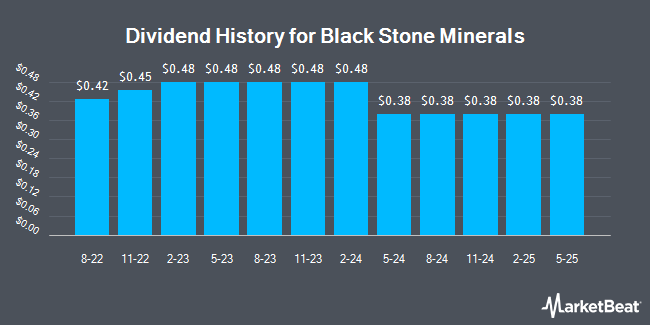Black Stone Minerals, L.P. (NYSE:BSM - Get Free Report) declared a quarterly dividend on Wednesday, October 15th. Investors of record on Thursday, November 6th will be paid a dividend of 0.30 per share by the oil and gas producer on Thursday, November 13th. This represents a c) dividend on an annualized basis and a dividend yield of 9.6%. The ex-dividend date of this dividend is Thursday, November 6th.
Black Stone Minerals has a payout ratio of 123.4% indicating that the company cannot currently cover its dividend with earnings alone and is relying on its balance sheet to cover its dividend payments. Research analysts expect Black Stone Minerals to earn $1.44 per share next year, which means the company may not be able to cover its $1.90 annual dividend with an expected future payout ratio of 131.9%.
Black Stone Minerals Stock Up 0.6%
Shares of Black Stone Minerals stock opened at $12.50 on Thursday. Black Stone Minerals has a 52-week low of $11.78 and a 52-week high of $15.66. The company has a 50 day moving average of $12.60 and a 200 day moving average of $13.21. The company has a quick ratio of 3.22, a current ratio of 3.22 and a debt-to-equity ratio of 0.12. The company has a market capitalization of $2.65 billion, a P/E ratio of 10.77 and a beta of 0.24.
Black Stone Minerals (NYSE:BSM - Get Free Report) last issued its quarterly earnings results on Monday, August 4th. The oil and gas producer reported $0.53 earnings per share (EPS) for the quarter, topping analysts' consensus estimates of $0.30 by $0.23. The company had revenue of $159.49 million during the quarter, compared to the consensus estimate of $112.19 million. Black Stone Minerals had a net margin of 61.21% and a return on equity of 39.67%. As a group, research analysts forecast that Black Stone Minerals will post 1.36 EPS for the current fiscal year.
Wall Street Analysts Forecast Growth
BSM has been the topic of a number of recent analyst reports. Zacks Research raised shares of Black Stone Minerals from a "strong sell" rating to a "hold" rating in a research report on Monday. Piper Sandler dropped their target price on shares of Black Stone Minerals from $14.00 to $13.00 and set a "neutral" rating on the stock in a research report on Thursday, August 14th. Finally, Weiss Ratings reaffirmed a "hold (c-)" rating on shares of Black Stone Minerals in a research report on Wednesday, October 8th. Four equities research analysts have rated the stock with a Hold rating, Based on data from MarketBeat, the company has an average rating of "Hold" and a consensus target price of $13.00.
Read Our Latest Stock Analysis on BSM
Black Stone Minerals Company Profile
(
Get Free Report)
Black Stone Minerals, L.P., together with its subsidiaries, owns and manages oil and natural gas mineral interests. It owns mineral interests in approximately 16.8 million gross acres, nonparticipating royalty interests in 1.8 million gross acres, and overriding royalty interests in 1.6 million gross acres located in 41 states in the United States.
Featured Articles

This instant news alert was generated by narrative science technology and financial data from MarketBeat in order to provide readers with the fastest and most accurate reporting. This story was reviewed by MarketBeat's editorial team prior to publication. Please send any questions or comments about this story to contact@marketbeat.com.
Before you consider Black Stone Minerals, you'll want to hear this.
MarketBeat keeps track of Wall Street's top-rated and best performing research analysts and the stocks they recommend to their clients on a daily basis. MarketBeat has identified the five stocks that top analysts are quietly whispering to their clients to buy now before the broader market catches on... and Black Stone Minerals wasn't on the list.
While Black Stone Minerals currently has a Hold rating among analysts, top-rated analysts believe these five stocks are better buys.
View The Five Stocks Here
Discover the 10 Best High-Yield Dividend Stocks for 2025 and secure reliable income in uncertain markets. Download the report now to identify top dividend payers and avoid common yield traps.
Get This Free Report
Like this article? Share it with a colleague.
Link copied to clipboard.